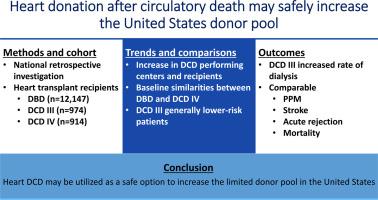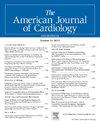Characteristics, Trends, and Outcomes of Heart Donation After Circulatory Death: An Early Analysis of the United Network for Organ Sharing Database
IF 2.1
3区 医学
Q2 CARDIAC & CARDIOVASCULAR SYSTEMS
引用次数: 0
Abstract
Heart transplantation (HTx) is greatly limited by organ shortage. To address this crisis, donation after circulatory death (DCD) is an emerging alternative to the traditional donation after brain death (DBD). Unfortunately, there is scarce data on HTx outcomes for this donation type, particularly within the United States; our investigation seeks to address this knowledge gap. As part of this study, the UNOS thoracic database was analyzed for first-time, adult, isolated orthotopic HTx recipients between 2019 and 2023. Patients were stratified into 3 groups: DBD, DCD III, and DCD IV. Further subgroup analysis for DCD III donors was conducted based on the procurement method, direct procurement and perfusion (DPP) or normothermic regional perfusion (NRP). After creating the sample cohort, a total of 14,035 HTx recipients were included in our analysis (DBD 86.5%, DCD III 6.9%, DCD IV 6.5%). There was an exponential increase in the number of DCD III cases and HTx centers that offer this donation type during the study period. DCD III recipients had a higher incidence of postoperative dialysis use; otherwise, all 3 groups shared similar rates of postoperative permanent pacemaker placement and stroke, acute rejection, and mortality. Within DCD III recipients, DPP and NRP procurement techniques had similar survival. To conclude, although DCD III was associated with an increased incidence of postoperative dialysis use, both DCD type III and IV had comparable morbidity and survival as the standard of care DBD donors. Overall, our investigation provides encouraging data to support DCD use as a safe option to increase the limited donor pool in the United States.

循环性死亡后心脏捐赠的特点、趋势和结果:器官共享数据库联合网络的早期分析。
由于器官短缺,心脏移植受到很大限制。为了解决这一危机,循环死亡后捐赠(DCD)是传统脑死亡后捐赠(DBD)的新兴替代方案。不幸的是,关于这种捐赠类型的HTx结果的数据很少,特别是在美国;我们的调查旨在解决这一知识差距。作为本研究的一部分,我们分析了UNOS胸腔数据库中2019-2023年间首次成人孤立原位HTx受者。将患者分为三组:DBD、DCD III和DCD IV。对DCD III供者进行进一步的亚组分析,基于采购方式、直接采购和灌注(DPP)或常温区域灌注(NRP)。在创建样本队列后,共有14035名HTx接受者被纳入我们的分析(DBD 86.5%, DCD III 6.9%, DCD IV 6.5%)。在研究期间,提供这种捐赠类型的DCD III病例和HTx中心的数量呈指数增长。DCD III型患者术后透析发生率较高;除此之外,三组患者术后永久性起搏器放置、卒中、急性排斥反应和死亡率相似。在DCD III接受者中,DPP和NRP采收技术具有相似的生存率。综上所述,尽管DCD III型与术后透析使用发生率增加有关,但作为DBD供者的标准护理,DCD III型和DCD IV型的发病率和生存率相当。总的来说,我们的调查提供了令人鼓舞的数据,支持使用DCD作为增加美国有限供体池的安全选择。
本文章由计算机程序翻译,如有差异,请以英文原文为准。
求助全文
约1分钟内获得全文
求助全文
来源期刊

American Journal of Cardiology
医学-心血管系统
CiteScore
4.00
自引率
3.60%
发文量
698
审稿时长
33 days
期刊介绍:
Published 24 times a year, The American Journal of Cardiology® is an independent journal designed for cardiovascular disease specialists and internists with a subspecialty in cardiology throughout the world. AJC is an independent, scientific, peer-reviewed journal of original articles that focus on the practical, clinical approach to the diagnosis and treatment of cardiovascular disease. AJC has one of the fastest acceptance to publication times in Cardiology. Features report on systemic hypertension, methodology, drugs, pacing, arrhythmia, preventive cardiology, congestive heart failure, valvular heart disease, congenital heart disease, and cardiomyopathy. Also included are editorials, readers'' comments, and symposia.
 求助内容:
求助内容: 应助结果提醒方式:
应助结果提醒方式:


